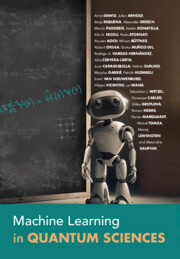Book contents
- Frontmatter
- Dedication
- Contents
- Contributors
- Preface
- Acknowledgments
- Note on the text
- Abbreviations
- 1 Introduction
- 2 Basics of machine learning
- 3 Phase classification
- 4 Gaussian processes and other kernel methods
- 5 Neural-network quantum states
- 6 Reinforcement learning
- 7 Deep learning for quantum sciences: Selected topics
- 8 Physics for deep learning
- 9 Conclusion and outlook
- A Mathematical details on principal component analysis
- B Derivation of the kernel trick
- C Choosing the kernel matrix as the covariance matrix for a Gaussian process
- References
- Index
7 - Deep learning for quantum sciences: Selected topics
Published online by Cambridge University Press: 13 June 2025
- Frontmatter
- Dedication
- Contents
- Contributors
- Preface
- Acknowledgments
- Note on the text
- Abbreviations
- 1 Introduction
- 2 Basics of machine learning
- 3 Phase classification
- 4 Gaussian processes and other kernel methods
- 5 Neural-network quantum states
- 6 Reinforcement learning
- 7 Deep learning for quantum sciences: Selected topics
- 8 Physics for deep learning
- 9 Conclusion and outlook
- A Mathematical details on principal component analysis
- B Derivation of the kernel trick
- C Choosing the kernel matrix as the covariance matrix for a Gaussian process
- References
- Index
Summary
This chapter discusses more specialized examples on how machine learning can be used to solve problems in quantum sciences. We start by explaining the concept of differentiable programming and its use cases in quantum sciences. Next, we describe deep generative models, which have proven to be an extremely appealing tool for sampling from unknown target distributions in domains ranging from high-energy physics to quantum chemistry. Finally, we describe selected machine learning applications for experimental setups such as ultracold systems or quantum dots. In particular, we show how machine learning can help in tedious and repetitive experimental tasks in quantum devices or in validating quantum simulators with Hamiltonian learning.
Keywords
Information
- Type
- Chapter
- Information
- Machine Learning in Quantum Sciences , pp. 184 - 220Publisher: Cambridge University PressPrint publication year: 2025
